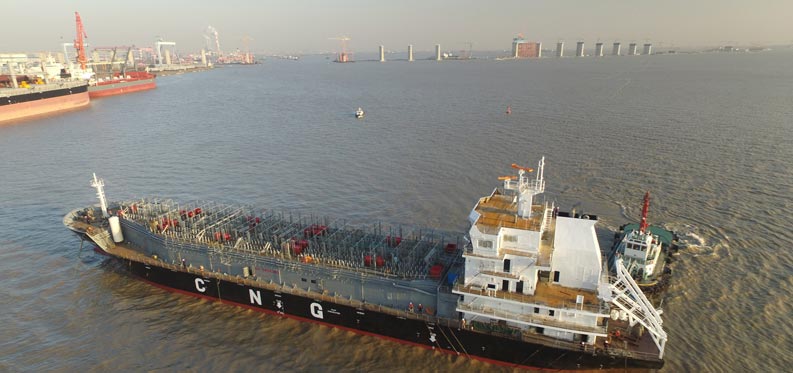News Release
04Month
2016
CIMC Enric Starts a New Chapter of World-wide CNG Transportation Industry

On January 25, 2016, the first global CNG carrier - Jayanti Baruna - was successfully launched at Jiangsu Hantong, marking the periodic progress of the commercialization of the idea of CNG carrier.
The manufacture of the carrier was led by Shijiazhuang Enric Gas Equipment Co., Ltd. (hereinafter referred to as “Shijiazhuang Enric”), primarily for the natural gas transportation for peak-shaving of power plant between the islands of a country in Southeast Asia. The carrier can transport 700,000 m3 CNG per voyage after put into operation.
CIMC Enric is currently the sole corporation that has realized multimodal transportation of Land, shipping and railway worldwide. The successful launch of Jayanti Baruna has broken the single approach of maritime transport of natural gas - LNG (Liquefied Natural Gas) transportation and initiated a new mode, or will rewrite the pattern of future maritime transport of natural gas.
Dating back to May, 2014, Shijiazhuang Enric, with its global leading manufacturing capacity of natural gas storage & transportation equipment, obtained the first order of CNG carrier project worldwide, mainly including constructions of “CNG storage device in primary filling station,” “CNG carrier” and “gas storing and discharging devices in secondary filling station.”
The project was formally started in January, 2015. For more than one year, Shijiazhuang Enric, owners, shipyards, classification society and partners make joint efforts to ensure the smooth installation and debugging of the CNG storage device in primary filling station, thus realizing the successful launch of carrier body.
It is known that natural gas is always delivered via pipelines, land vehicles, railways and maritime transport. With respect to maritime transport, LNG transport has been the mainstream. By far many countries have been exploring practices of CNG carriers, which however, fail to enter the implementation phase due to many reasons. Yang Baoying, Deputy General Manager of CIMC Enric Holdings Ltd. said: “Efficiency explains why the idea of CNG carrier has never been put into practice even the transport cost is much lower. In terms of long-distance transport, LNG carrier is more advisable, for its capacity of the same volume triples that of CNG carrier; the market of offshore transport tends to be smaller. The invitation of bidding for CNG carrier primary results from the appropriate distance between the two islands as well as the low demand for natural gas for the peak-shaving of power plant. ”
As insiders said, compared to CNG transport, more natural gas can be delivered with containers of the same volume in LNG transport. However, LNG transport requires more complex process and higher construction cost in that prior to transport the gas has to undergo liquefied storage, and then has to be gasified before usage; furthermore, to maintain the liquefied status during transport, the temperature of the insulated container has to be kept at -162°C. While in CNG transport the gas has merely to be compressed before shipment, and directly piped to end-users after decompression upon the arrival at discharging port. Once entering the market and widely accepted, CNG transport mode will largely help reduce the waste of offshore gas.



